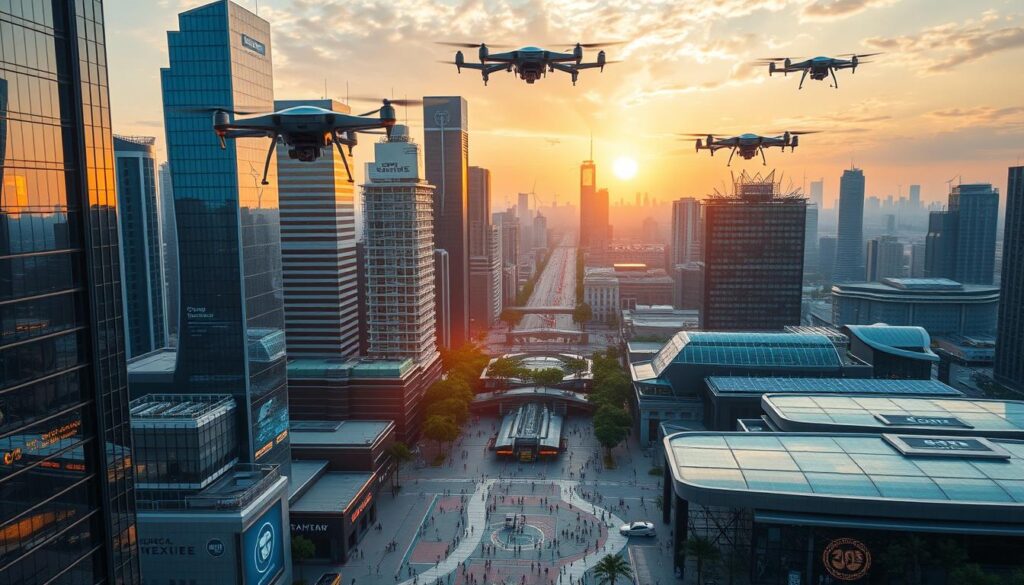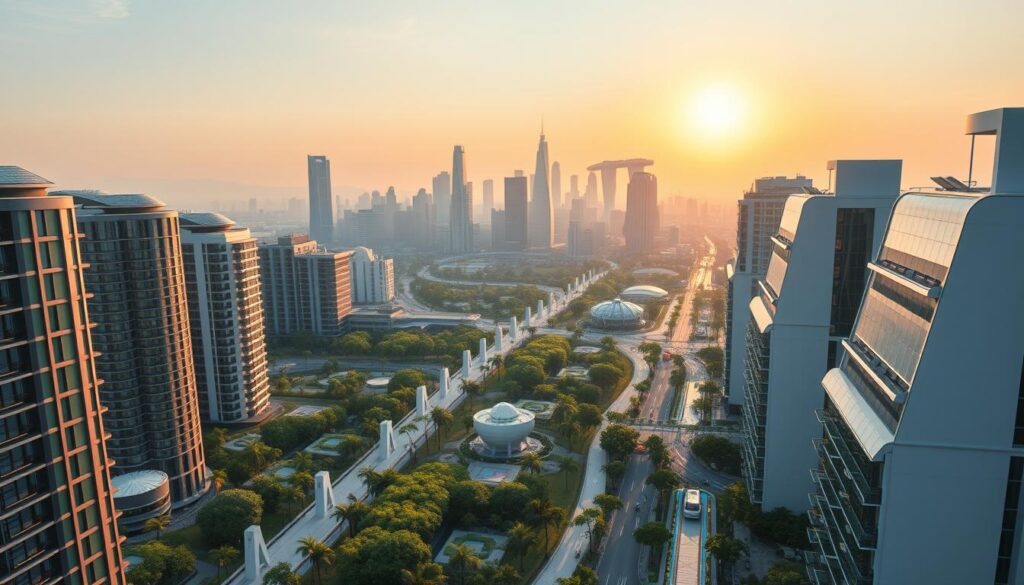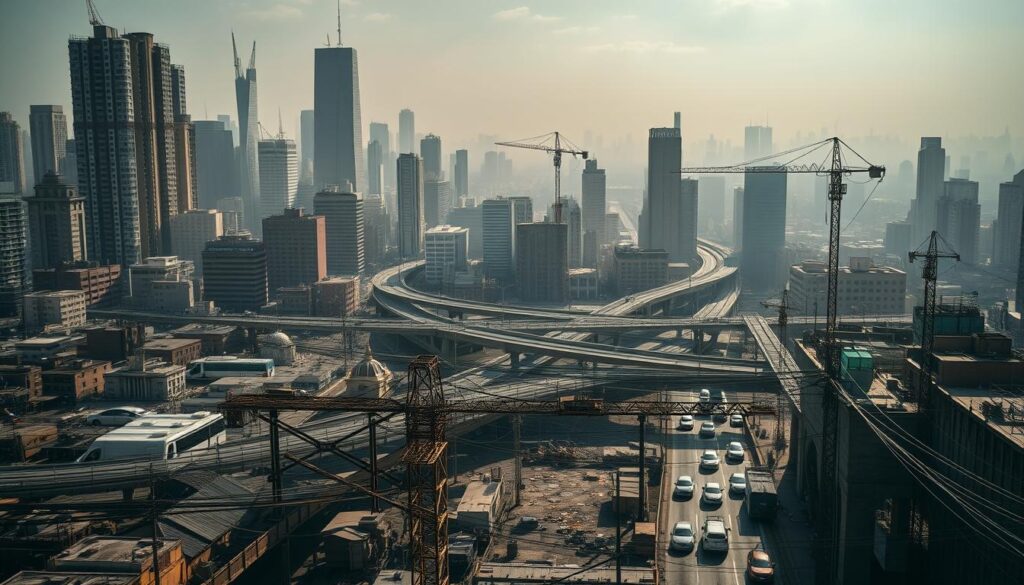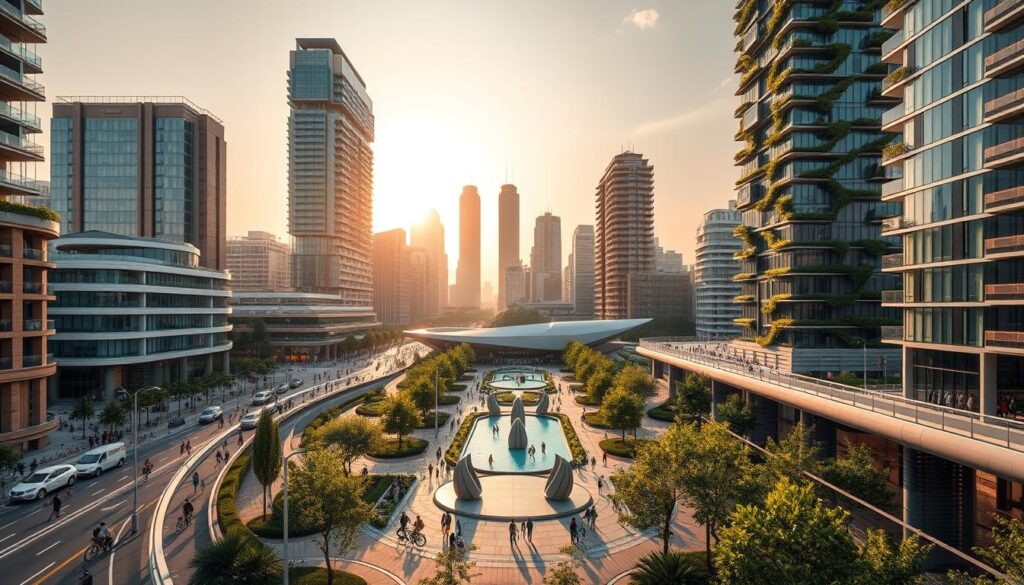As the world’s population continues to urbanize, cities face unprecedented challenges in providing infrastructure that is efficient, sustainable, and equitable. The need for innovative design solutions has never been more pressing.
Cities are at the forefront of this challenge, requiring smart transportation systems and sustainable infrastructure to accommodate growing populations. Effective planning is crucial, as seen in the development of transportation networks that prioritize efficiency and sustainability.
Key Takeaways
- Efficient infrastructure is crucial for sustainable city development.
- Innovative design solutions can enhance urban livability.
- Smart transportation systems are key to accommodating growing populations.
- Sustainable infrastructure planning is essential for future cities.
- Effective transportation networks require careful planning and execution.
Introduction to Urban Infrastructure Design
The future of urban living depends heavily on the effective design and management of urban infrastructure. As cities continue to expand and evolve, the need for well-planned infrastructure becomes increasingly critical.
What is Urban Infrastructure Design?
Urban infrastructure design encompasses the planning, design, and management of urban systems, including transportation, energy, water, and waste management. It is a comprehensive approach that aims to create livable, sustainable, and resilient cities. Effective urban infrastructure design is crucial for supporting the health, safety, and productivity of urban populations.
Importance in Modern Cities
In modern cities, urban infrastructure design plays a vital role in addressing the challenges posed by urbanization, such as congestion, pollution, and resource depletion. By incorporating green urban infrastructure and smart city infrastructure elements, cities can reduce their environmental footprint and enhance the quality of life for their citizens.
For a deeper dive into mastering urban infrastructure, you can explore resources like Mastering Urban Infrastructure: A Definitive Guide, which provides comprehensive insights into urban development strategies.
Key Components
The key components of urban infrastructure design include:
| Component | Description |
|---|---|
| Transportation Systems | Efficient public transit, pedestrian, and cycling infrastructure |
| Energy Management | Renewable energy sources and energy-efficient buildings |
| Water Management | Sustainable water supply and waste water management systems |
| Waste Management | Effective waste disposal and recycling programs |
These components are integral to creating modern urban infrastructure that is both sustainable and resilient.
Historical Overview of Urban Infrastructure
From ancient civilizations to modern metropolises, the history of urban infrastructure is a testament to human ingenuity and adaptation. The development of urban infrastructure has been a continuous process, shaped by various factors including technological advancements, societal needs, and environmental considerations.
Evolution Through the Ages
Urban infrastructure has its roots in ancient civilizations, where early cities were designed with sophisticated water management systems and public spaces. For instance, ancient Rome’s aqueducts and public baths are iconic examples of early urban infrastructure. As cities evolved, so did their infrastructure, adapting to the needs of their populations.
Key Developments in Urban Infrastructure:
- Ancient civilizations: Early water management and public spaces
- Medieval period: Fortifications and basic road networks
- Industrial Revolution: Significant advancements in transportation and sanitation
Impact of Industrialization
The Industrial Revolution marked a significant turning point in the history of urban infrastructure. As industries grew, cities expanded, and the need for modern infrastructure became pressing. This period saw the introduction of railways, modern sewage systems, and other critical infrastructure that transformed urban living.
The impact of industrialization on urban infrastructure can be seen in the rapid growth of cities and the development of new technologies. According to a brief history of urban infrastructure, this period was crucial in shaping modern urban landscapes.

Lessons from the Past
Understanding the historical context of urban infrastructure provides valuable lessons for modern urban planning. By examining past successes and failures, urban planners can develop more sustainable and resilient cities. For example, the integration of green spaces into urban design, as seen in some historical cities, can enhance the quality of life for residents.
| Historical Period | Key Infrastructure Developments | Lessons for Modern Cities |
|---|---|---|
| Ancient Civilizations | Water management systems, public spaces | Importance of public spaces, sustainable water management |
| Industrial Revolution | Railways, modern sewage systems | Need for modern, efficient transportation and sanitation systems |
| Modern Era | Smart cities, renewable energy integration | Embracing technology and sustainability in urban planning |
For more insights on infrastructure design and construction, visit World Civil Society.
Fundamental Principles of Urban Infrastructure Design
Effective urban infrastructure design hinges on three pivotal principles: sustainability, accessibility, and resilience. These principles are essential for creating livable and sustainable cities that meet the needs of their inhabitants while minimizing their impact on the environment.
Sustainability
Sustainability in urban infrastructure design involves practices that reduce environmental degradation and promote eco-friendly development. This includes incorporating green urban infrastructure such as green roofs, solar panels, and rainwater harvesting systems. For more insights on sustainable infrastructure design, visit 7 Key Principles of Sustainable Infrastructure.
Some key strategies for sustainable urban planning include:
- Implementing energy-efficient systems
- Using sustainable materials in construction
- Promoting public transportation and non-motorized transport
Accessibility
Accessibility is crucial for ensuring that urban infrastructure serves all members of the community, regardless of age or ability. This involves designing public spaces, transportation systems, and buildings that are inclusive and usable by everyone.
| Accessibility Feature | Description | Benefit |
|---|---|---|
| Wide, Curb-Free Sidewalks | Easy navigation for pedestrians and wheelchair users | Enhanced mobility and safety |
| Accessible Public Transport | Ramps and lifts on buses and trains | Increased independence for all users |
| Tactile Signage | Braille and tactile markers on signs | Better navigation for visually impaired individuals |
Resilience
Resilience in urban infrastructure design refers to the ability of cities to withstand and recover from natural disasters, economic crises, and other challenges. This involves designing infrastructure that is adaptable and can evolve with the needs of the city.
Key strategies for enhancing resilience include:
- Implementing flood protection measures
- Diversifying energy sources to include renewables
- Developing flexible transportation networks
By integrating these principles, cities can create a robust and sustainable urban infrastructure that supports the well-being of their citizens and fosters a high quality of life.
The Role of Technology in Urban Infrastructure
Technology plays a crucial role in shaping the future of urban infrastructure, making cities more sustainable and efficient. The integration of advanced technologies is transforming the way cities operate, making them more livable and responsive to the needs of their citizens.
Smart Cities and IoT Integration
The concept of smart cities is becoming increasingly popular, with the Internet of Things (IoT) being a key driver. IoT integration enables the connection of various devices and systems, allowing for real-time data collection and analysis. This data is used to optimize urban services, improve infrastructure management, and enhance the quality of life for citizens. For instance, smart traffic management systems can reduce congestion by optimizing traffic light timings based on real-time traffic data.

The benefits of IoT integration in urban infrastructure are numerous. It enables cities to become more efficient, reduce energy consumption, and improve public safety. For example, smart lighting systems can adjust their brightness based on the time of day and ambient light, reducing energy waste.
Impact of Artificial Intelligence
Artificial Intelligence (AI) is another technology that is making significant inroads in urban infrastructure. AI algorithms can analyze vast amounts of data to predict maintenance needs, detect anomalies, and optimize resource allocation. This proactive approach helps in preventing failures and reducing downtime in critical infrastructure.
AI-powered chatbots are also being used to improve citizen engagement by providing quick and efficient responses to queries and concerns. This not only enhances the citizen experience but also helps in reducing the workload on city officials.
Data-Driven Decision Making
Data-driven decision making is at the heart of smart city initiatives. By leveraging data from various sources, cities can make informed decisions that are based on empirical evidence rather than intuition. This approach helps in optimizing urban planning, improving public services, and enhancing overall efficiency.
For example, data analytics can help in identifying areas with high crime rates, allowing law enforcement agencies to deploy resources more effectively. Similarly, data on energy consumption patterns can help in designing more efficient energy distribution systems.
In conclusion, technology is playing a vital role in transforming urban infrastructure. Through smart cities, IoT integration, AI, and data-driven decision making, cities are becoming more sustainable, efficient, and livable. As technology continues to evolve, it is expected that urban infrastructure will become even more responsive to the needs of citizens, paving the way for a brighter future.
Urban Transport Systems
Urban transport systems play a critical role in shaping the livability and sustainability of cities. As urban populations continue to grow, the need for efficient, reliable, and environmentally friendly transport solutions becomes increasingly pressing.
Public Transit Innovations
Public transit innovations are at the forefront of urban transport development. Cities are adopting smart bus systems and advanced rail networks to enhance efficiency and reduce emissions. For instance, the implementation of real-time tracking and smart traffic management systems can significantly improve the reliability and appeal of public transit.
According to a guide on urban transport infrastructure, integrating public transit with other modes of transport can create a seamless travel experience, encouraging more people to use public transport.
Walkable City Concepts
Creating walkable cities is another crucial aspect of sustainable urban planning. Walkable city concepts focus on designing urban spaces that prioritize pedestrian access and safety. This includes the development of pedestrian-friendly infrastructure, such as wide sidewalks, crosswalks, and pedestrian zones.
Walkable cities not only promote physical health but also contribute to the economic vitality of urban areas by making them more attractive to residents and visitors alike.
Cycling Infrastructure
Cycling infrastructure is a vital component of urban transport systems, providing a sustainable and healthy alternative to motorized transport. Cities are investing in dedicated bike lanes and bike-sharing programs to encourage cycling.
Effective cycling infrastructure can reduce traffic congestion, lower emissions, and enhance the overall quality of urban life. It is essential to design cycling infrastructure that is safe, accessible, and well-integrated with other transport modes.
Green Spaces in Urban Areas
Green spaces are transforming urban landscapes, enhancing livability and sustainability. As cities continue to grow, the importance of integrating green infrastructure into urban planning cannot be overstated.

Urban greenery provides numerous benefits, including improved air quality, reduced urban heat island effects, and enhanced mental health for residents. Green urban infrastructure is not just aesthetically pleasing; it’s a critical component of sustainable urban design.
Benefits of Urban Greenery
The benefits of urban greenery are multifaceted. For instance, parks and recreational areas serve as vital spaces for community activities, promoting social cohesion and physical health. Moreover, urban greenery helps in mitigating the effects of climate change by absorbing carbon dioxide and reducing pollution.
According to recent studies, cities that invest in green infrastructure see a significant improvement in the quality of life for their residents. For more information on how green infrastructure can be integrated into urban planning, visit CityGreen’s guide on green infrastructure.
Designing Parks and Recreational Areas
Designing effective parks and recreational areas requires careful consideration of urban design principles. These spaces should be accessible, safe, and well-maintained to encourage community use. Incorporating elements of nature, such as water features or native plant species, can enhance the aesthetic appeal and ecological value of these areas.
Integrating Nature into Urban Design
Integrating nature into urban design involves more than just creating parks; it’s about weaving green spaces throughout the urban fabric. This can include green roofs, vertical gardens, and street trees. By doing so, cities can create a more sustainable and resilient urban environment.
In conclusion, green spaces are essential for creating livable and sustainable cities. By understanding the benefits of urban greenery and applying sound urban design principles, cities can enhance the quality of life for their residents.
Water and Waste Management
Sustainable urban development relies heavily on efficient water and waste management systems. Effective management of these resources is critical for maintaining public health, supporting economic development, and protecting the environment.
Sustainable Water Solutions
Implementing sustainable water solutions is essential for urban areas. This includes using advanced technologies to conserve water, reduce leakage, and promote efficient use. Water recycling and reuse are also vital components of sustainable water management.
“The key to sustainable water management is not just about conserving water, but also about managing it in a way that supports the needs of both the environment and the community.”
Some of the strategies for sustainable water solutions include:
- Implementing water-saving technologies
- Promoting water conservation practices among citizens
- Developing infrastructure for water recycling
Effective Waste Disposal Strategies
Effective waste disposal is crucial for maintaining a clean and healthy urban environment. This involves implementing efficient waste collection systems, promoting recycling, and minimizing landfill waste. Waste-to-energy technologies are also being adopted to reduce the environmental impact of waste.
| Waste Disposal Method | Environmental Impact | Cost Efficiency |
|---|---|---|
| Landfill | High | Low |
| Recycling | Low | Medium |
| Waste-to-Energy | Medium | High |
Rainwater Harvesting Techniques
Rainwater harvesting is a simple yet effective technique for conserving water. It involves collecting and storing rainwater for various uses such as irrigation, toilet flushing, and even drinking water. Rainwater harvesting systems can significantly reduce the demand on municipal water supplies.
- Reducing stormwater runoff
- Conserving potable water
- Lowering water bills
Energy Efficiency in Urban Design
Sustainable urban planning hinges on the effective implementation of energy-efficient designs and technologies. As cities continue to expand, the need to reduce energy consumption and reliance on non-renewable sources becomes increasingly critical.
Renewable Energy Sources in Cities
Cities are now leveraging renewable energy sources such as solar, wind, and hydroelectric power to meet their energy demands. Renewable energy not only reduces the carbon footprint of urban areas but also provides a sustainable alternative to fossil fuels.
- Solar energy integration through photovoltaic panels on buildings
- Wind energy harvesting using turbines in suitable locations
- Hydroelectric power generation where feasible
Building Energy-Efficient Structures
The design and construction of energy-efficient buildings play a crucial role in urban energy efficiency. This involves using materials and designs that minimize energy consumption for heating, cooling, and lighting.
| Building Feature | Description | Energy Saving Potential |
|---|---|---|
| Insulated Building Envelopes | Reduces heat loss in winter and heat gain in summer | High |
| Double Glazed Windows | Minimizes heat transfer and reduces UV exposure | Medium to High |
| Energy-Efficient Lighting | Uses LED and other low-energy lighting solutions | High |
Energy Management Systems
Effective energy management systems are essential for monitoring and optimizing energy use in urban areas. These systems help in identifying areas of inefficiency and implementing corrective measures.

By integrating renewable energy sources, building energy-efficient structures, and implementing advanced energy management systems, cities can significantly reduce their energy consumption and environmental impact.
Community Engagement in Urban Planning
Effective urban planning hinges on the active participation of the community, ensuring that the needs and aspirations of citizens are reflected in the design processes. This collaborative approach not only fosters a sense of ownership among citizens but also leads to more sustainable and livable cities.
Involving Citizens in Design Processes
Involving citizens in urban design processes is crucial for creating infrastructure that meets the needs of its users. This can be achieved through various methods, including public meetings, surveys, and online platforms. By engaging citizens, planners can gather valuable insights into community needs and preferences.
For instance, a study published on Springer Link highlights the importance of community participation in urban planning, demonstrating its positive impact on project outcomes.
Benefits of Community Feedback
Community feedback is a vital component of urban planning, offering numerous benefits. It helps in identifying potential issues early on, ensures that projects are aligned with community needs, and fosters a sense of community ownership.
Key Benefits:
- Increased project acceptance
- Better alignment with community needs
- Enhanced sense of community ownership
Case Studies of Successful Engagement
Several cities have successfully implemented community engagement strategies in their urban planning processes. For example, the redevelopment of the waterfront in a major U.S. city involved extensive community engagement, resulting in a vibrant public space that reflects the community’s vision.
| City | Project | Engagement Method |
|---|---|---|
| New York | Waterfront Redevelopment | Public Meetings, Surveys |
| Chicago | Park Renovations | Community Workshops |
| San Francisco | Transportation Planning | Online Platforms, Public Hearings |
In conclusion, community engagement is a cornerstone of effective urban planning. By involving citizens in design processes and incorporating community feedback, cities can create infrastructure that is not only sustainable but also reflects the needs and aspirations of its citizens.
The Role of Government and Policy
Government policies play a pivotal role in shaping the future of urban infrastructure. Effective governance is crucial for creating sustainable, livable cities that meet the needs of their citizens.
Zoning Laws and Regulations
Zoning laws are a critical tool used by governments to regulate land use and ensure that urban development is orderly and beneficial to the community. By designating areas for specific uses such as residential, commercial, or industrial, zoning laws help prevent conflicts between different land uses and promote a more organized urban environment.
Proper zoning can also enhance the aesthetic appeal of cities and protect environmental resources. For instance, zoning regulations can be used to preserve green spaces, protect water bodies, and ensure that development is sensitive to the natural landscape.

Funding and Investment Strategies
Funding is a significant challenge in urban infrastructure development. Governments must employ innovative funding strategies to finance infrastructure projects. This can include public-private partnerships (PPPs), government bonds, and grants. For example, a city might use a PPP to finance a new public transportation system, with the private sector handling the construction and operation in exchange for a return on investment.
For more insights on cutting construction costs, visit this guide on reducing construction costs in Africa, which provides valuable strategies applicable to urban infrastructure projects worldwide.
Collaborations with Private Sector
Collaboration with the private sector is increasingly recognized as a vital component of successful urban infrastructure development. The private sector brings not only financial resources but also expertise and innovation. Through PPPs, governments can leverage the strengths of private companies to deliver high-quality infrastructure projects.
Effective collaboration requires clear communication, mutual trust, and a well-defined agreement outlining the roles and responsibilities of each party. When done correctly, such collaborations can lead to more efficient project delivery and better outcomes for citizens.
Case Studies of Innovative Urban Infrastructure Projects
Major U.S. cities are at the forefront of implementing cutting-edge urban infrastructure solutions. These innovative urban projects are not only transforming the urban landscape but also providing valuable insights into future trends.
Examples from Major U.S. Cities
Cities like New York, San Francisco, and Chicago are leading the way in urban infrastructure innovation. For instance, New York City’s Hudson Yards project is a prime example of a smart city infrastructure development, incorporating advanced green technology and efficient energy management systems.
- San Francisco’s public transit system has been upgraded with real-time tracking and smart traffic management.
- Chicago’s green infrastructure initiatives have significantly reduced urban flooding.
Lessons Learned from Successful Projects
The success of these urban infrastructure solutions can be attributed to several key factors, including community engagement, innovative financing models, and the integration of technology. For example, the use of data analytics in urban planning has enabled cities to make more informed decisions.
“The future of urban infrastructure lies in its ability to adapt to changing environmental conditions and to incorporate sustainable practices.”
Future Trends in Urban Infrastructure
As cities continue to evolve, future trends in urban infrastructure are expected to focus on sustainability, resilience, and smart technology. Some of the emerging trends include:
- Increased use of renewable energy sources.
- Implementation of advanced water management systems.
- Integration of AI and IoT in urban planning.
These innovative urban projects and case studies provide a roadmap for the development of sustainable and efficient urban infrastructure, shaping the cities of tomorrow.
Challenges in Urban Infrastructure Design
Urban infrastructure design faces a myriad of challenges, from budget constraints to climate change. As cities continue to grow and evolve, addressing these challenges becomes increasingly important for sustainable urban development.
Budget Constraints
One of the significant challenges in urban infrastructure design is overcoming budget constraints. Cities often have limited financial resources, making it difficult to fund large-scale infrastructure projects. To address this, cities can explore public-private partnerships and innovative financing models to secure the necessary funding.
A detailed analysis of budget allocation can help identify areas where costs can be optimized without compromising the quality of infrastructure. For instance, using cost-effective materials and efficient construction techniques can significantly reduce project costs.
| Strategy | Description | Potential Savings |
|---|---|---|
| Public-Private Partnerships | Collaboration between government and private entities to fund infrastructure projects. | Up to 30% |
| Cost-Effective Materials | Using materials that offer similar quality at lower costs. | 15-25% |
| Efficient Construction Techniques | Adopting methods that reduce construction time and labor costs. | 10-20% |
Aging Infrastructure
Dealing with aging infrastructure is another critical challenge. Many cities have infrastructure that is decades old and in need of repair or replacement. Regular maintenance and upgradation are essential to prevent infrastructure failures and ensure safety.
Implementing a predictive maintenance schedule can help identify potential issues before they become major problems. This proactive approach can extend the lifespan of infrastructure and reduce the need for costly repairs.

Adapting to Climate Change
Adapting to climate change is a pressing challenge in urban infrastructure design. Rising sea levels, extreme weather events, and changing precipitation patterns require infrastructure to be resilient and adaptable. Climate-resilient design involves incorporating features that can withstand these changes.
Some strategies for climate-resilient design include elevating critical infrastructure, using flood-resistant materials, and implementing green infrastructure to manage stormwater runoff. These measures can help cities mitigate the impacts of climate change.
The Future of Urban Infrastructure Design
Urban infrastructure design is on the cusp of a revolution, driven by emerging technologies and changing societal needs. As we look to the future, it’s clear that the cities of tomorrow will be shaped by innovative design principles and a commitment to sustainability.
Predictions for the Next Decade
Over the next decade, urban infrastructure design will be influenced by several key trends. Smart city technologies will become more prevalent, enabling cities to manage resources more efficiently and respond to challenges in real-time. Additionally, there will be a growing focus on sustainable urban living, with cities incorporating more green spaces and energy-efficient buildings.
Emerging Technologies to Watch
Several emerging technologies will play a crucial role in shaping the future of urban infrastructure design. These include Internet of Things (IoT) devices, which will enable cities to collect and analyze data on everything from traffic flow to energy usage. Artificial intelligence (AI) will also be used to optimize urban systems, from public transportation to waste management.
Vision for Sustainable Urban Living
A key aspect of the future of urban infrastructure design is a vision for sustainable urban living. This involves creating cities that are not only environmentally friendly but also livable and resilient. Cities will need to incorporate more green infrastructure, such as parks and green roofs, to mitigate the effects of climate change and improve air quality.
By embracing these emerging technologies and design principles, cities can create a more sustainable and livable future for their citizens.
Conclusion: The Path Forward for Urban Infrastructure
As cities continue to evolve, it’s clear that sustainable urban planning is crucial for creating livable and resilient urban environments. By 2050, nearly 70% of the world’s population is expected to live in urban areas, putting a strain on existing infrastructure.
Collaboration and Innovation
Effective collaboration among stakeholders is essential for creating sustainable and livable cities. This involves working together to design and implement innovative urban infrastructure solutions that prioritize energy efficiency, green spaces, and low-carbon transport systems.
Call to Action
Urban planners, policymakers, and citizens must work together to embracing change and drive innovation in urban infrastructure design. By doing so, we can create cities that are not only sustainable but also resilient and adaptable to future challenges.
Shaping the Future
By prioritizing sustainable urban planning and investing in innovative urban infrastructure, we can create a better future for urban residents. This requires a commitment to collaboration, a willingness to embracing change, and a focus on delivering call to action that benefits both people and the planet.
